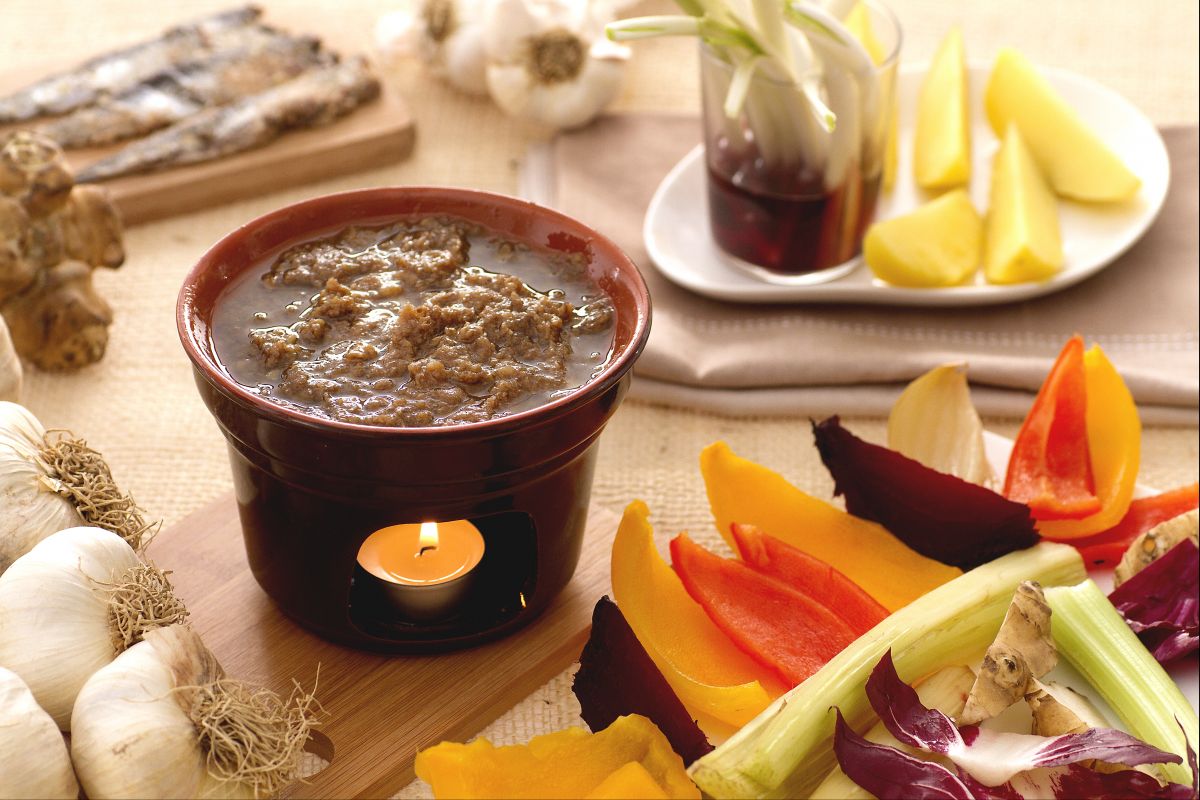Ossobuco alla Milanese with Yellow Risotto
- Average
- 4 h
- Kcal 57

Bagna cauda or bagna caoda is a traditional preparation from Piedmont made with anchovies, oil, and garlic, used as a dip for fresh seasonal autumn vegetables. Being a hearty dish, it is usually considered a main course but sometimes can also serve as an appetizer for a dinner among friends... Indeed, it was precisely during gatherings and dinners among friends that this dish was prepared, which over time became a symbol of friendship and joy. The origins of bagna cauda are somewhat shrouded in mystery as it is not precisely known when, where, and who invented this dish, which in fact does not even have a city of residence, but it is known instead that the late Medieval vintners adopted this recipe to celebrate an extremely important event such as the tapping of the new wine. For a very long time, bagna cauda remained only the dish of the poor and peasants because the aristocrats abhorred it for its abundance of garlic. Over time, this dish has been re-evaluated and, nowadays, many trattorias and restaurants, especially in Piedmont, include bagna cauda in their menu. Regarding the origin of the name, we know that bagna cauda comes from the two terms, "bagna" which in Piedmontese means sauce or gravy, and "cauda" which means hot: so hot sauce.
And it is precisely for this reason that bagna cauda is served in "fujot", special terracotta or copper containers with a flame underneath that keeps the dip warm. Here we present the classic recipe registered with the Italian Cuisine Academy and a version prepared with milk that is equally tasty. Accompany the bagna cauda with typical autumnal vegetables of the region, among which the famous cardoon of Nizza Monferrato stands out, to be consumed raw.

To prepare the bagna cauda, start by peeling the garlic heads, removing each clove's skin 1, then with a small knife score the cloves in half and remove the germ 2 and slice them 3.

Set aside the garlic and work on desalting the salted anchovies: place the anchovies in a bowl 4 and cover them with cold water 5, soak them for 2-3 hours, changing the water often to remove the salt. Perform this operation very gently to avoid breaking the anchovies. Once the anchovies have softened, drain them 6

split them in half 7 and remove the innards with the central bone 8 and rinse them under running water 9.

Then line a small tray or a baking dish with paper towels and arrange the opened fillets on it. Dry the fillets 10 then place them in a baking dish and wash them with red wine, stirring gently (11-12). Transfer the anchovies back to a tray

and dry them with paper towels 13. Place the garlic in a saucepan and pour 3.5 oz of olive oil 14, start cooking over very low heat, stirring with a wooden spoon and making sure it does not take on color. Add the anchovies 15, stirring gently.

Cover with the remaining oil 16 and cook the mixture over low heat for about half an hour, making sure the bagna does not fry 17. Meanwhile, prepare the vegetables to accompany the bagna cauda, start with the cooked ones: roast the onions in the oven with their skin, then cut them into wedges 18,

boil the potatoes in water, they should not be too soft so that they can be cut into wedges 19 finally bake the beetroot and cut it like the other vegetables 20. Roast the peppers in the oven and cut them into wedges as well 21.

Now move on to the raw vegetables: wash the cardoons remove the ends 22 and the outer filaments and cut them in half lengthwise. Wash the spring onions and dip them in wine, better if Barbera, as tradition wants 23. Once the anchovies have melted, your bagna cauda will be ready to be served at the table, preferably in the characteristic "fujot" 24.

To prepare the milk bagna cauda, start by peeling the garlic heads 1 setting aside the whole cloves, then with a small knife score the cloves in half and remove the germ 2 and slice them 3.

Set aside the garlic and work on desalting the salted anchovies: place the anchovies in a bowl and cover them with cold water 4, soak them for 2-3 hours, changing the water often to remove the salt. Perform this operation very gently to avoid breaking the anchovies. Once the anchovies have softened, drain them 5 then split them in half 6

and remove the innards with the central bone 7 and rinse them under running water 8. Then line a small tray or a baking dish with paper towels and arrange the opened fillets on it. Place the garlic cloves in a small pot and pour fresh milk 9, bring to a boil,

then let it simmer on very low heat for 15/20 minutes until the garlic softens 10. Place half a glass of oil in a saucepan and then add the anchovies 11, continue cooking over low heat, making sure not to fry the oil, stir with a wooden spoon to melt the anchovies 12.

When the anchovies have turned into a cream, pour the garlic cooked in milk into the saucepan 13. Stir to combine the ingredients 14 and add the remaining oil 15, cook over low heat for 20-30 minutes, the oil should never fry and the sauce should have a creamy consistency. Once the cooking is complete, serve the milk bagna cauda in the characteristic "fujot" and accompany it with vegetables as per tradition.